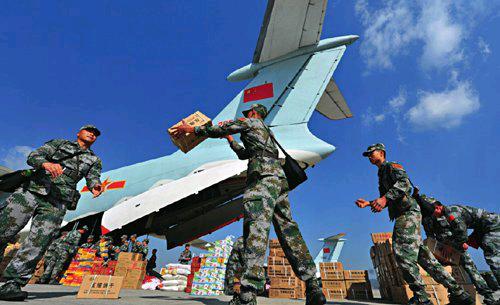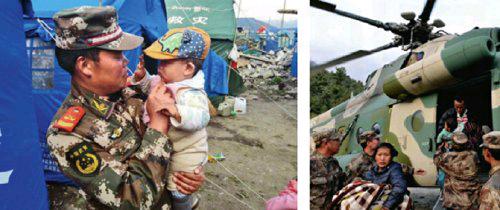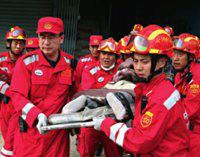China Mobilizes in Nepal Rescue Effort
AN 8.1-magnitude earthquake struck Nepal at 11:56 am on April 25 local time. The quake was so huge it affected neighboring Chinas Tibet Autonomous Region. By 00:00 am the next day, Xigaze in the southwest of the Tibetan plateau had been jolted by 10 aftershocks measuring above 3.0 on the Richter scale, with the strongest registering a magnitude of 7.0. By May 5 the death toll in Nepal had risen to 7,566, and the injured numbered 14,500 or more. There were 25 deaths recorded in China.
Rush to the Rescue
Following the quake the Nepalese government declared a state of emergency in 29 of the worst hit regions, several of them located in the Kathmandu valley. According to the local military, close to 90 percent of buildings in the valley had been flattened. And the capital city Kathmandu saw the worst of it. About three fifths of buildings at the famous Durbar Square were completely devastated, with the rest grimly damaged; and the land- mark Dharahara (Bhimsen) Tower was reduced to ruins.
China followed closely the earthquake in Nepal, and expressed grave concerns and sympathies. President Xi Jinping and Premier Li Keqiang sent messages to their Nepalese counterparts the day the catastrophe struck, extending their deep condolences to the victims and sincere solicitude to the bereaved families and the injured. The following day, April 26, Chinas International Rescue Team arrived in Nepal to carry out disaster relief work. Consisting of 69 rescuers, medical workers, and earthquake experts, together with six sniffer dogs and plenty of medical apparatus, it was the first heavily-equipped international rescue team recognized by the UN. Within four hours the team had found the first survivor in northwestern Kathmandu, a man in his 20s.
According to the Ministry of Home Affairs of Nepal, Chinese aid workers carried out effective rescue and relief missions in several of the hardest hit areas, including the capital and Sindhupalchok. In this mountainous district in northeastern Nepal, the aid work was severely hampered by landslides and mangled roads incurred by the strong tremors. The Chinese team moved swiftly to the affected area to clear the roads.
At the request of the Nepalese government, a group consisting of the Chinese Peoples Armed Police bringing 180 engineering machines entered Nepal from southwestern Tibet on May 3 to help restore the 114 km road link from Zham Port to Kathmandu. Local media reported that many injured Nepalese were transferred to Tibetan hospitals for better treatment.endprint
In the early hours of April 26, a 58-member medical team dispatched by the Chinese government also headed for Nepal. Including experts in such fields as critical care, pharmacology, orthopedics, nursing, and psychology, it offered treatment, hygiene, epidemic prevention, and trauma therapy services to quake victims. By May 5 they had received more than 600 Nepalese and treated 500-plus of them. The number of Chinese medical teams rose to five and the next stage of the aid effort from China was in the pipeline pending the specific needs on the ground in Nepal.
Valerie Amo, UN under-secretary-general for humanitarian affairs and emergency relief coordinator, applauded the Chinese medical teams that had been providing assistance in quake-stricken Nepal as highly efficient in conducting operations. “It was very reassuring to see the very high quality of work theyve done. They have conducted a great deal of operations.”
The Chinese government offered two rounds of humanitarian aid worth RMB 60 million for Nepal, and its military pledged 650 tons of aid materials.
By May 6 Chinese aid workers in Nepal had retrieved two survivors and 18 bodies, treated 2,900 persons, and operated 35 flights by eight transport planes and three helicopters, airlifting 408 tons of aid supplies.
China has learned ample expertise and experience in response to natural disasters. It effectively put the situation under control in the wake of the massive Wenchuan earthquake in 2008.
Given the tremendous destruction inflicted by the April 25 quake in Nepal, a prolonged period of rebuilding efforts is predicted. “We have already asked Nepal what they need and we will send experts for more detailed discussions,” said Huang Xilian, deputy head of the Asian Department at Chinas Foreign Ministry. He noted that reconstruction of heavily damaged infrastructure, re-housing of victims, and restoration of historical buildings would be prioritized. More than 300,000 houses were brought down in the quake and aftershocks, and a good number of historical and world heritage sites were ruined, whose repair requires the combined help of the international community.
“I would like to extend my sincere thanks and gratitude to the people of China for the support that we have received in this difficult time of natural calamities,” said President Yadav in his office, which was also partly damaged in the quake. The president praised the expertise of the Chinese quake-relief teams and said he hoped that the Nepalese government would further coordinate with the Chinese government to overcome the disaster.endprint
China also sent airlines to rescue 5,685 stranded Chinese citizens in the quake-hit country.“The Foreign Ministry emergency call hotline played a critical role in this rescue mission,”said Zhai Leiming, deputy chief of the ministrys Department of Consular Affairs. In the first five days after the quake the hotline received nearly 500 calls, 10 times more than its normal inflow, which involved about 2,000 Chinese people from all over the country including Hong Kong, Macao, and Taiwan. Starting on April 30 the Foreign Ministry called each person back one by one, and was told most of them were in safe locations.
Quake-relief at Home
Chinas Tibet was also affected by the earthquake. Its Nyalam, Gyirong, Tingri, Saga, Zhongba, Yadong, Lhaze, and Burang counties were among the hardest hit. In Xigaze in southwestern Tibet, which borders Nepal, the quake had claimed 20 lives, injured 58, and left four unaccounted for by 00:00 am of April 27. It also flattened more than 1,200 homes and ruined 54 monasteries. Close to 25,000 people were displaced. The local government dispatched 17,000 personnel and 30-odd heavy machines for the rescue operation.
On April 27, a delegation headed by Vice Minister of Civil Affairs Dou Yupei, who is also secretary-general of the China National Commission for Disaster Reduction, set out for Tibet to lead rescue and aid work there. Its members were from eight departments of the State Council, including the Ministry of Finance, Ministry of Land and Resources, Ministry of Housing and Urban-rural Development, Ministry of Transport, National Health and Family Planning Commission, and China Earthquake Administration.
The latter dispatched 22 people to help with aid work in Tibet, and the National Commission for Disaster Reduction and the Ministry of Civil Affairs allocated 15,000 tents, 30,000 cotton-padded coats, 30,000 quilts and 15,000 each of foldable beds and sleeping bags among other materials for the aid operation. The China Red Cross also shipped emergency aid supplies worth RMB 1.01 million that included tents, quilts, and clothing.
The top priority of aid work is to save lives, and the second is to clear roads so that aid personnel and supplies can smoothly and swiftly come in.
The avalanche triggered by the quake at Mount Qo- molangma caused one Chinese death on the south side of the mountain and eight injuries, two of them critical. A Chinese national from Shanghai, who joined an international climbing team, lost contact. Through concerted efforts all the injured and some climbers were moved to safe locations.endprint
A Quake-prone Region
Nepals records since 1255 show evidence of one 8.0 plus-magnitude earthquake about every 80 years, and one between 7.5 and 8.0 on the Richter scale every 40 years for the past centuries. The Nepalese, therefore, hold this belief. The deadliest earthquake, measuring 8.4, occurred in January 1934 and killed 8,519, the highest death toll in the countrys recorded history.
Nepal straddles the famous Mediterranean-Himalaya earthquake belt. The latest quake was the result of the collision of two tectonic plates, the Indian Plate and the Eurasian Plate.
Scientists predict more strong aftershocks in the coming months, which might bring down more buildings in Nepal, given their poor quake-resistance. Whats more, there is a possibility of breaching of barrier lakes in the mountainous areas that could cause flooding in the lower reaches. Such scenarios demand precaution.
This century has seen five earthquakes at or above a magnitude of 8.0 in the terrestrial area of the planet. According to Jiang Haikun, chief of the forecast section of the China Earthquake Networks Center, the 9.0-magnitude quake in Sumatra in 2004 heralded in a highfrequency era for quakes at or above 8.0 magnitude, recalling to memory the first half of the 20th century, when several powerful tremors jolted the planet.endprint

